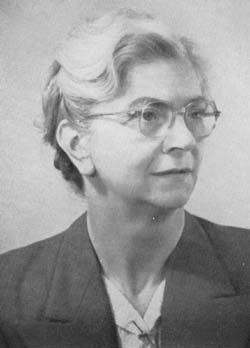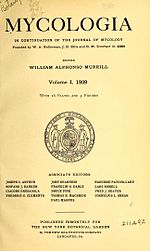
The Polyporaceae are a family of poroid fungi belonging to the Basidiomycota. The flesh of their fruit bodies varies from soft to very tough. Most members of this family have their hymenium in vertical pores on the underside of the caps, but some of them have gills or gill-like structures. Many species are brackets, but others have a definite stipe – for example, Polyporus badius.

William Alphonso Murrill was an American mycologist, known for his contributions to the knowledge of the Agaricales and Polyporaceae. In 1904, he became the assistant Curator at the New York Botanical Garden (NYBG). He, along with the NYBG, founded the journal Mycologia and was its first editor for 16 years. Murrill was known to travel extensively to describe the mycota of Europe and the Americas. He traveled along the East Coast, Pacific Coast, Mexico and the Caribbean. Although Murrill was a very influential person at the NYBG, having worked his way up to become assistant director in 1908, his rather eccentric personality caused problems with his job. He went on annual collecting trips to Mexico, the Caribbean, Europe, and South America, sometimes, without informing any of his colleagues prior. These trips resulted in a cumulative total of 70,000 specimens, 1,400 of which are deposited in the NYBG.

Pulveroboletus is a genus of fungi in the family Boletaceae. The genus has a cosmopolitan distribution and contains 41 species.

Favolus, or honeycomb fungus, is a genus of fungi in the family Polyporaceae. The fruit bodies of Favolus species are fleshy with radially arranged pores on the underside of the cap that are angular and deeply pitted, somewhat resembling a honeycomb.
Gertrude Simmons Burlingham was an early 20th-century mycologist best known for her work on American Russula and Lactarius and pioneering the use of microscopic spore features and iodine staining for species identification.
Howard James Banker was an American mycologist. He received his PhD from Columbia University in 1908. Banker was an associate editor of the journal Mycologia starting from its establishment in 1909, until it became the official publication of the Mycological Society of America in 1933. He published several papers in the journal, including a revision of the North American Hydnaceae, which discussed 62 species in 10 genera. Banker died at his home in Huntington, New York, in 1940. The genus Bankera is named after him.

Carlo Luigi Spegazzini, in Spanish Carlos Luis Spegazzini, was an Italian-born Argentinian botanist and mycologist.

Charles Christopher Frost was an American mycologist. He described several species of fungi from the New England area of the United States. In one paper, Frost described 22 new species of boletes, and he was later credited with the discovery of three additional species. His personal herbarium of specimens were given to the University of Vermont in 1902. Portions of his collection today are distributed between the Farlow Herbarium at Harvard University, the New York State Museum, the Bell Museum of Natural History, and the Buffalo Museum of Science.
Sanford Myron Zeller was an American mycologist.

Edwin Butterworth Mains (1890–1968) was an American mycologist. He was known for his taxonomic research on the rust fungi (Pucciniomycetes), the genus Cordyceps, and the earth tongues (Geoglossaceae).

Albert Pilát was a Czech botanist and mycologist. He studied at the Faculty of Science at Charles University, under the guidance of Professor Josef Velenovský. In 1930, he joined the National Museum, eventually becoming head of the Mycological Department, and in 1960 a corresponding member of the academy. He was the author of many popular and scholarly publications in the field of mycology and mountain flora. He also served as the main editor of the scientific journal Czech Mycology, and described several species of fungi. His areas of particular interest include polypores and boletes. He explored the Carpathians looking for fungi and travelled widely. Between 1933 and 1948 he edited the exsiccata series Fungi Carpatici lignicoli exsiccati. He was also a skilled photographer.
Louis Charles Christopher Krieger was an American mycologist and botanical illustrator who was considered the finest painter of North American fungi.
Gladys Elizabeth Baker was an American mycologist, teacher, and botanical illustrator, known for her extensive work in biological and mycological education, and the morphological study of myxomycete fructifications. She further contributed studies to the Island Ecosystems Integrated Research Program of the U. S. International Biological Program.

Elias Judah Durand was an American mycologist, and botanist. He was one of the foremost American experts on the discomycetes.

Edith Katherine Cash was an American mycologist.

David Ross Sumstine was an American educator and mycologist.

Lilian Edith Hawker was a British mycologist, known for her work on fungal physiology, particularly spore production. She was an expert on British truffles, and also published in the fields of plant physiology and plant pathology. She was also known for her contributions to education in mycology. Most of her career was spent at the botany department of the Imperial College of Science and Technology (1932–45) and the University of Bristol (1945–73), where she held the chair in mycology (1965–73) and was dean of the science faculty (1970–73). She served as president of the British Mycological Society, and was elected an honorary member of that society and of the Mycological Society of America. She published an introduction to fungi and two books on fungal physiology, of which Physiology of Fungi (1950) was among the first to survey the field, and also co-edited two microbiology textbooks.












